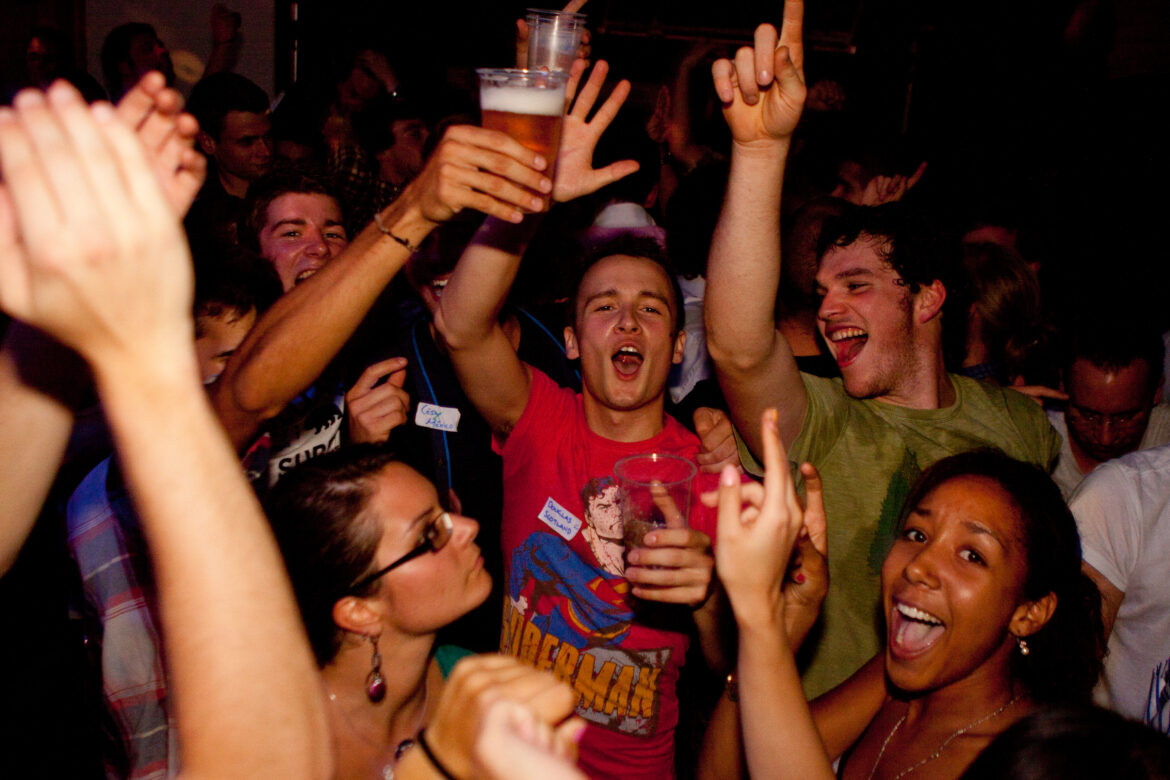Compared to many places worldwide, the United States has a relatively high drinking age. The age limit for purchasing alcohol both on- and off-premise sits at 21 in contrast with the minimums of European and South American countries at around 18 or 19. With the rise of popular media has come a sharp increase in the portrayal of drinking on television screens and in song lyrics. A study completed by Northwestern University found that over a fifth of the songs on the Billboard’s Hot 100 list mentioned alcohol. Brand placement in TV shows and media also subliminally encourages viewers to partake. Moreover, when examining the portrayal of alcohol consumption in TV, 40% of episodes depict drinking “as an overall positive experience” while only 10% illustrate it as “a negative one,” despite discussing detrimental consequences in23% of episodes. Outside of the media, culture is a major contributing factor to the glorification of alcohol in the United States. College campuses are some of the most concentrated locations for mass drinking, which can have disastrous impacts on their student bodies.
One of the primary risks of a low drinking age is the susceptibility to addiction. A study conducted by researchers at Columbia University found that approximately 90% of adults with a substance addiction began using as a minor. In contrast, only 4% of adults with an addiction began using after the age of 21. This suggests that starting to drink later may decrease the risk of addiction. Returning to the subject of college campuses, fraternity parties are another important influence on drinking culture. Participants in Greek life are, in general, linked to higher rates of “binge drinking and drug use” than their peers. This is likely due to a combination of peer pressure and a pre-established tradition of binge drinking and reckless alcohol consumption at fraternity and sorority parties and events. Moreover, the practice of hazing as a form of initiation into Greek life is known for incorporating heavy drinking. Since 2000, approximately 60 people have died of substance abuse due to hazing in the United States, most being alcohol-rated. Since fraternities rarely ID their guests, this also contributes to higher rates of underage and inexperienced drinking, which can prove dangerous for those uneducated on safe drinking practices. The dire truth of the matter is that college students already risk being roofied (drugged) or sexually assaulted by predatory classmates looking to take advantage of them at these frat parties, and adding alcohol into the mix only lowers awareness and increases the chance of something bad happening.
Another aspect of college drinking culture is clubbing. Though many students in their first few years of college are too young to legally go clubbing, many still do so with the use of fake IDs, or by finding bars and clubs with less vigilant bouncers. Though the rate of students with fakes is not initially high at the start of college, it rises across semesters as a result of many succumbing to the pressure to participate in partying. It’s important to note that drinking for many college students doesn’t begin once they arrive at the club. “Pre-gaming” is the practice of drinking with friends before going out as a cost-efficient way to drink. This typically involves binge drinking hard liquor to get as drunk as possible before leaving for the club, that way the buzz lasts throughout the night. Such rapid consumption of alcohol is not healthy nor safe and while many manage to end each night all right and satisfied with their outing, not all are so lucky. Across the decades, deaths by alcohol poisoning for youths aged 18-24 have risen, indicating a somber trend for college students’ alcohol consumption.
Given the research on addictive substance use by adolescents, it is understandable why the United States chooses to keep its drinking age at 21. However, it is arguable that this places a greater emphasis on the ability to partake in drinking than necessary. Specifically, there is a particular thrill to engaging in the illegality of underage drinking that is ultimately harmful to teens and young adults. When many first begin drinking, it is without their parents knowing and with little proper education or guidance on how to do so safely. By allowing adolescents to begin drinking in controlled environments like “restaurants, taverns, pubs and official school and university functions” under the supervision of adults, proper drinking behaviour can be modelled, and should any emergencies occur, help can be provided. One of the scariest parts of college underage drinking is the fact that it is kept so hidden due to being illegal. No one wants to get in trouble, making students less likely to ask for help in the case of any problems, despite the life-changing impact unsafe drinking can have.
Youth alcoholism is not a problem isolated to the United States. The majority of Europe drinks more alcohol per person than Americans and Europeans are more likely to begin drinking at a younger age. This suggests maybe a mass shift regarding drinking culture is required by the global population. The allure of alcohol should be deemphasized and society must stop ignoring the negative consequences of reckless drinking. It is not “cool” nor safe to end a night of clubbing by throwing up on the sidewalk outside the venue and the glorification of this behaviour is creating lasting problems for new generations of college students. Sparking a nonjudgemental dialogue about alcoholism and safe drinking practices is important to fixing the problem.
Edited by Lilya Boumehraz

Hannah Hipólito is in her first year at McGill University pursuing a Joint Honours BA in Political Science and Sociology. She enjoys researching and writing about public policy and culture, especially in relation to education, civil rights, and gun control.

